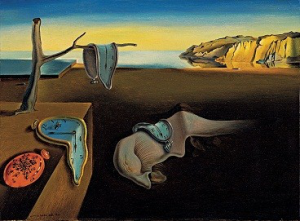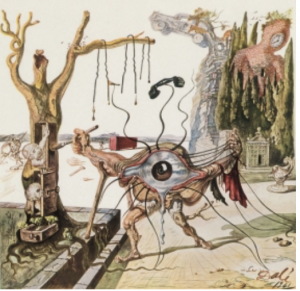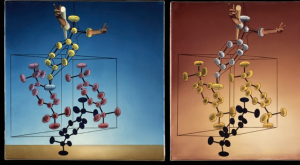I have been intending to explore art and science fiction in at least one of my blog posts. In pursuit of this, I began to think about if I have encountered the themes, concerns, or styles of science fiction represented in an artistic format. What came to mind was something I had seen when I was in Cadaqués, Spain a coastal town North of Barcelona. Salvador Dali spent many years of his life in this small town, and maintained a residence on the ocean front. On top of his home here is a massive egg sculpture (pictured below).

I saw this egg from distance while on a walk around the coast. This egg and the experience of encountering it, to me, reflect the uncanniness, the “out-of-place”-ness, and the distortion of the “normal” that are so characteristic of the science fiction genre. With this a launching off point, I spent some time exploring Dali and his artwork.
This was a great article – provided by the Dali museum that discussed Dali’s interest in science:
Salvador Dali was quite interested in science, mathematics, immortality, biology, evolution, and the origins of life. Dali engaged with science from an early age, starting by reading scientific articles and later participating in forums and gatherings of artists and scientists interested in the intersection between their respective disciplines. The article suggests that his library of science-based texts, on topics such as physics, quantum mechanics, and biology demonstrates his passion for the sciences. The article also discusses Dali’s attention to the observations of Sigmund Freud, particularly his ideas surrounding the conscious, unconscious, dreams, freedom, and the rational. In addition, Dali lived through great periods of technological and social advancement including: War World I, the testing of the Atomic Bomb during World War II, and the exploration of genetics and DNA in the 1960’s and 70’s. Dali’s deep interest and real study of science is reflected in his surrealist art and the focus of many of his works including: inner-paranoia, double-images, 3-D worlds, optical illusion, time, relationships between internal and external reality.
The website from where this article was taken also has a timeline gallery of Dali’s works by year. It is interesting to see how his work changed over the years – you can tell how he was influenced by what was occurring in the world at the time. From perusing the gallery I was drawn to these paintings that had a SF ~vibe~ to them. The first one, “The Persistence of Memory” was painted in 1931. The second and third paintings were done in the 1940’s – to me they reflect the despair and horror of wartime – a concern for the SF genre . The last painting was done in 1973 and is titled “The Structure of DNA.”





Yay! Dali’! I am a fan. Happy to see the connections you have made between his art and science. (if interested, I co-wrote an article on Dali’s watercolor illustrations of Dante’s Paradiso and the concept of the 4th dimension). He was deeply influenced by the mathematics theoretical physics of his time.
Also, in Taveres’s “Stuntmind” the main character is named Van Dali’. A fusion of Van Gogh and Dali’, perhaps. Why, do you think, is art so central to that story?